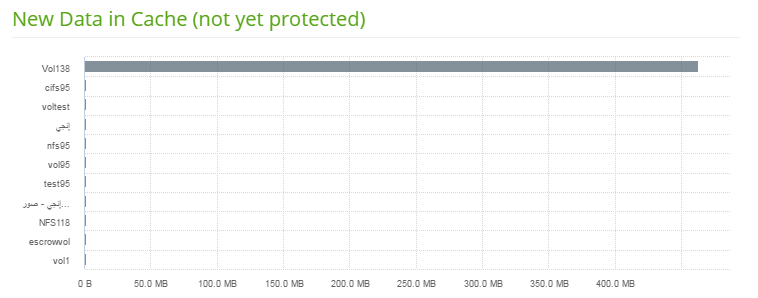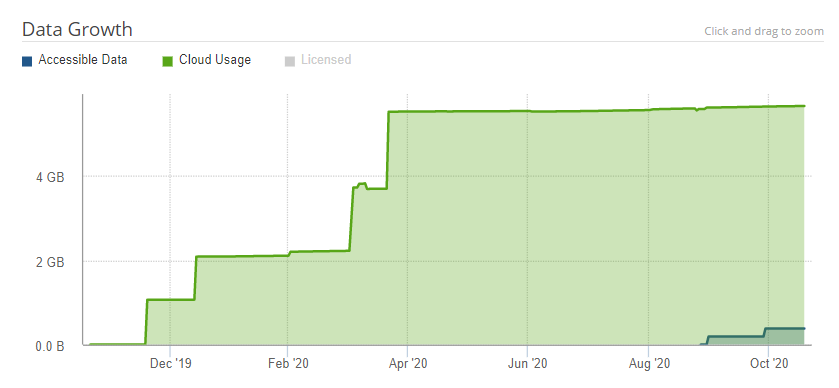Overview
Nasuni uses a number of data metrics to measure the amount of data that customers store using the Nasuni service. The goal of this document is to clarify the meaning and usage of these data metrics so that customers can understand and plan for their data storage needs.
For a summary of data metrics, see Summary of Data Metrics.
Details of data limits are described in the Terms of Service, available here: https://www.nasuni.com/legal/#terms_of_service
Note: Nasuni Edge Appliances and the NMC display the size of data in base 10 units (including MB = 1,000,000 bytes, GB = 1,000,000,000 bytes, and TB = 1,000,000,000,000 bytes).
In contrast, some platforms display the size of data in base 2 units (including MB = 1,048,576 bytes, GB = 1,073,741,824 bytes, and TB = 1,099,511,627,776 bytes).
For example, a file that Nasuni displays as 10 MB would be displayed by some platforms as 9.53 MB.
“Licensed Data” or “Licensed Capacity” or “Storage Volume Limit”
Licensed Data is sometimes also called “Licensed Capacity” or “Storage Volume Limit” in documents such as the Nasuni Terms of Service.
Licensed Data has these characteristics:
Licensed Data is the amount of data storage that Nasuni is managing for a customer, and that the customer is paying to store using the Nasuni service.
Every customer has a Licensed Data limit. No customer has unlimited storage. However, every customer has unlimited versions of their data available. Since the Nasuni service is inherently unlimited, the Licensed Data limit can easily be changed, as business needs change.
The default Licensed Data for trial accounts is 5 TB.
If the Used data or “Now” data (see “Used data or “Now” Data” below) exceeds the Licensed Data for a Nasuni Edge Appliance, the following occur:
All the data on the Nasuni Edge Appliance remains fully accessible.
All versions of data on the Nasuni Edge Appliance remain fully accessible.
Customers can continue to add data to the Nasuni Edge Appliance.
Nasuni receives a notification of the condition.
The customer may increase the amount of Licensed Data, by purchasing additional amounts.
The customer may reduce the amount of Used data or “Now” data by removing files, directories, or volumes.
Used data or “Now” Data
The Nasuni Management Console displays Used data or so-called “Now” data.

Used data shows the total amount of stored data for each volume versus time. You can use Used data to monitor the amount of data stored using a Nasuni Edge Appliance, and to determine how much data each volume contributes to the total.
Used data or “Now” data has these characteristics:
Used data or “Now” data is the metric that is compared to a customer’s Licensed Data. For example, if the Licensed Data is 10 TB and the Used data or “Now” data is 11 TB, the data exceeds the license, regardless of any other metric.
However, other metrics might also be part of the license, such as number of Nasuni Edge Appliances or number of volumes.Used data or “Now” data is sometimes expressed as a percentage of Licensed Data. For example, if a customer’s Used data or “Now” data is 90 percent, this means that the amount of Used data or “Now” data is 90 percent of the Licensed Data.
Used data or “Now” data is data contained in a volume on a Nasuni Edge Appliance that has been written to the cloud.
Used data or “Now” data includes all data in the UniFS®-powered cloud volume, and represents data written by the Nasuni Edge Appliance owning the volume, as well as data written by any Nasuni Edge Appliances that have also attached to the volume.
Used data or “Now” data does not include “New Data in Cache (not yet protected)” from any of the attached Nasuni Edge Appliances (see below).
Used data or “Now” data includes the current version of data only.
Used data or “Now” data does not include previous versions. For example, if there are 20 former versions of a 1-MB document, the Used data or “Now” data of that document is still only 1 MB, not 20 MB.
Nasuni offers unlimited versions of data.Used data or “Now” data does not include deleted data, even though the customer can typically still access the deleted data through previous versions. For example, if a customer has 500 GB in a volume, then deletes 100 GB, their Used data or “Now” data is 400 GB, even though they can still access all 500 GB of data.
Used data or “Now” data includes metadata. Metadata is information about your data, including the contents of folders, names of items, sizes of items, ACLs, owner information, group information, and so forth. The metadata for small files can exceed the size of the file itself, and a collection of many small files can result in a large amount of metadata, although, typically, metadata represents only a small percentage of normal filesystem capacity.
Used data or “Now” data is data as you stored it in the Nasuni system. Before data is sent to cloud storage, Nasuni breaks data into multiple chunks, then encrypts and compresses it. Used data or “Now” data is based on the data before any of these size-reducing, security-enhancing, and performance-improving modifications are performed.
Note: For this reason, Used data or “Now” data is typically larger than the cloud-optimized data format.
“New Data in Cache (not yet protected)” or ”Data Not Yet Protected”
The Nasuni Edge Appliance user interface displays a chart of “New Data in Cache (not yet protected)”.

The Nasuni Management Console displays a chart of “Data Not Yet Protected”.
.png)
Both are bar charts showing the amount of new data in the cache that has not yet been protected in cloud storage. Each volume appears on the vertical axis on the left side. The amount of data for each volume appears as a horizontal bar. If all the data for a volume has already been protected in cloud storage, there is no bar for that volume.
You can use this chart to monitor how much data is present in the cache that has not yet been protected in cloud storage. If you hover the mouse over one of the bars, a label appears, displaying details about the amount of data not yet protected in that Nasuni Edge Appliance or volume.
“New Data in Cache (not yet protected)” or “Data Not Yet Protected” has these characteristics:
“New Data in Cache (not yet protected)” or “Data Not Yet Protected” is not included in Used data or “Now” Data.
“New Data in Cache (not yet protected)” or “Data Not Yet Protected” is not compared to a customer’s Licensed Data.
Accessible Data
Accessible Data describes overall account data. Accessible Data includes data already protected in the cloud, as well as data in the cache that is not yet protected. For this reason, the volume data in the cache that is not yet protected is generally less than the total accessible volume data, unless this volume has not completed any snapshots. Accessible Data is current data only. Accessible Data does not include metadata.
Accessible Data is displayed on the Data Growth chart (NMC) and on the Subscription Status page (NEA).
Content Size
Content Size describes the size of a file, folder, or volume. Content Size includes data already protected in the cloud, but does not include data in the cache that is not yet protected. Content Size is current data only. Content Size does include metadata.
Content Size is displayed on the File System Browser (NMC and NEA).
Cloud Usage
If the customer license includes public (aka BYOC) or private cloud storage providers, and if the amount of data stored with public or private cloud providers is greater than zero, then Cloud Usage data is also available. Cloud Usage data includes the size in the cloud of all data and metadata protected in the cloud, for all versions, after encryption and compression. Cloud Usage represents the actual size of Nasuni’s representation of data in the cloud.
Accessible Data is displayed on the Data Growth chart (NMC).

Comparison of Cloud Usage and Accessible Data
Summary of Data Metrics
Where observed | Scope of data | Actual data | Current data | Uncompressed or compressed | Includes previous versions / snapshots | Includes unprotected | Includes protected data in cloud | Includes metadata | |
Accessible Data | Data Growth chart (NMC) Subscription Status (NEA) | Account data | Actual | Current | Uncompressed | No | Yes | Yes | No |
Cloud Usage | Data Growth chart (NMC) | Account data | Actual | All | Compressed | Yes | No | Yes | Yes |
Content Size | File System Browser (NMC, NEA) | Volumes, directories, and files in File System Browser | Actual | Current | Uncompressed | No | No | Yes | Yes |
“Now” | Used data (Account Status page, NMC) | Account data | Actual | Current | Uncompressed | No | No | Yes | Yes |
Licensed Data = | Data Growth chart (NMC) Compare to Used data (Account Status page, NMC) | Account data | Licensed limit to data | Current | Uncompressed | No | No | Yes | Yes |
Questions?
If you have any questions about these data metrics, or how they apply to your account, contact your Customer Success Manager, or Nasuni Technical Support.
Copyright © 2010-2025 Nasuni Corporation. All rights reserved.